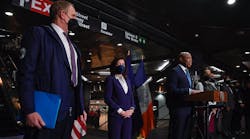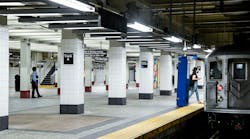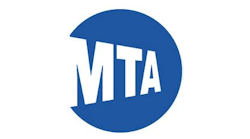MTA, NYPD to put an additional 1,200 officers on subway daily
The state of New York, New York City and Metropolitan Transportation Authority (MTA) are taking additional steps that they believe will deliver enhanced safety to the city’s subway system. The actions build off the entities’ joint efforts and will see additional police officers in the system, new units to assist in homeless and mental illness intervention and enhanced intervention training for law enforcement and first responders.
“[This] announcement is possible because of the partnership between city and state to assure the safety of our subway system,” said MTA Chair and CEO Janno Lieber. “Subway ridership has surged since Labor Day, and we remain focused on growing rider confidence through increased deployment of uniformed officers, cameras installed in every subway car, and further progress on quality-of-life issues.”
Law enforcement ‘omnipresence’
A law enforcement surge will see approximately 1,200 overtime shifts daily to the subway system. The added officers will be strategically deployed throughout the system with MTA Police Department taking primary responsibility for the subway stations adjacent and linked to MTA’s four major commuter rail hubs: New York Penn Station, Grand Central Station, Atlantic Terminal and Sutphin-Archer (Jamaica) Station. NYPD officers will then provide coverage at additional stations across the subway system, which will result in at least 300 stations seeing law enforcement coverage during peak hours.
There will reportedly be additional officers at turnstiles and MTA will place security guards at certain subway stations to offer an increased security presence and deter fare evasion.
“The NYPD and the MTA are proud partners in the ongoing work to keep all of those who use our subway trains and stations safe,” said NYPD Commissioner Keechant L. Sewell. “Utilizing seamless collaboration, police omnipresence and proactive communications with the riding public, we will deepen our ability to ensure a safer transit system — and a safer city.
Assistance for unhoused, mentally ill
New York Gov. Kathy Hochul directed New York State Office of Mental Health (OMH) to create two new, dedicated 25-bed Transition to Home Units (THUs) to address the unhoused population sheltering in the subway system and those who are suffering from severe mental illness.
The first 25-bed unit will launch at Manhattan Psychiatric Center (MPC) by Nov. 1 with a second unit opening next year after OMH evaluates capacity at downstate psychiatric hospitals. As part of this new initiative, OMH will develop a Community Residential Step-Down Program to provide a transitional space for people who are being discharged directly from the THUs. This short-term residential program will include 15 units across four locations for a total of 60 transitional beds and provide service recipients with the opportunity to acquire the skills needed to move to a more independent housing setting. Individuals will also be supported in procuring benefits to ensure long-term success.
“My number one priority as governor is keeping New Yorkers safe in the streets, in their homes, in their schools, and on the subway, and we will do whatever it takes to make our subways safer for riders,” said Gov. Hochul. “Our expanded subway safety strategy of Cops, Cameras, and Care will crack down on subway crime, help those experiencing homelessness get the support they need to get out of the system and alleviate concerns of riders to ensure New Yorkers feel safer throughout the subway system.”
In addition, OMH will expand crisis intervention training for MTA Police, the NYPD, and EMS/EMT, teaching them best practices for engaging individuals experiencing homelessness and ensuring they are fully informed of the statutory authority for the transport of individuals in need of a psychiatric evaluation. These expanded initiatives build on ongoing collaboration between the city and state on subway safety and outreach to the population experiencing homelessness.
NYC Mayor Eric Adams and Gov. Hochul also pledged to explore strengthening and improving laws providing assistance to those suffering from serious mental health illness.
“We must address both the perception and reality of safety and the expanded partnership … will do just that, while building off the successes of our Subway Safety Plan. The bottom line is that riders will see more officers in the system and so will those thinking of breaking the law,” said Mayor Adams.
Camera installation, conductor call outs
Last week, MTA highlighted a practice it has implemented to have conductors alert riders when an officer is onboard and where officers can be found on station platforms.
“If you're on a 10-car train, it's incredibly difficult to see if a police officer is on a platform. With these announcements, subway riders can now know that an officer is at a station or on their train,” said New York City Transit President Richard Davey. “I think that it certainly will prevent crime, make sure that people feel safe, and that people are safe.”
MTA will also continue its initiative to install cameras on subway cars and in stations. In September, MTA and New York City Transit were awarded a $2 million federal grant to install cameras across the entire subway fleet.
MTA’s plan is to have camera coverage inside of more than 6,500 subway cars, which should happen in late 2024. The authority is in the middle of the procurement process for additional cameras but has 100 on hand that will be installed across subway cars shortly.
In September 2021, MTA said cameras had been installed at 100 percent of its 472 subway stations.

Mischa Wanek-Libman | Group Editorial Director
Mischa Wanek-Libman is director of communications with Transdev North America. She has more than 20 years of experience working in the transportation industry covering construction projects, engineering challenges, transit and rail operations and best practices.
Wanek-Libman has held top editorial positions at freight rail and public transportation business-to-business publications including as editor-in-chief and editorial director of Mass Transit from 2018-2024. She has been recognized for editorial excellence through her individual work, as well as for collaborative content.
She is an active member of the American Public Transportation Association's Marketing and Communications Committee and served 14 years as a Board Observer on the National Railroad Construction and Maintenance Association (NRC) Board of Directors.
She is a graduate of Drake University in Des Moines, Iowa, where she earned a Bachelor of Arts degree in Journalism and Mass Communication.






